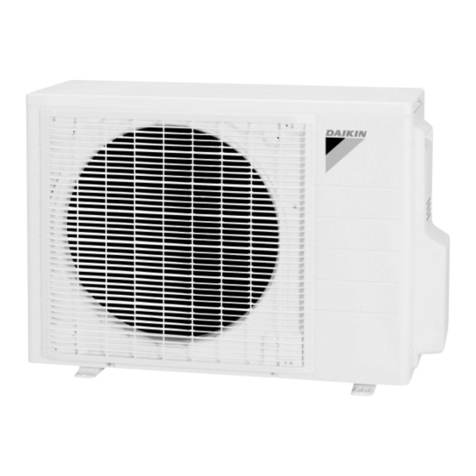
3
To assure that your unit operates safely and efciently, it
must be installed, operated, and maintained in accordance
with these installation and operating instructions, all local
building codes and ordinances, or in their absence, with the
latest edition of the National Fuel Gas Code NFPA54/ANSI
Z223.1 and National Standard of Canada CAN/CSA B149
Installation Codes.
ePa reGulatiOns
imPOrtant: the uniteD states envirOnmental PrOteCtiOn
aGenCy (ePa) has issueD variOus reGulatiOns reGarDinG
the intrODuCtiOn anD DisPOsal Of refriGerants in this
unit. failure tO fOllOw these reGulatiOns may harm the
envirOnment anD Can leaD tO the imPOsitiOn Of substantial
fines. beCause reGulatiOns may vary Due tO PassaGe Of new
laws, we suGGest aCertifieD teChniCian PerfOrm any wOrk
DOne On this unit. shOulD yOu have any questiOns Please
COntaCt the lOCal OffiCe Of the ePa.
natiOnal CODes
This product is designed and manufactured to permit instal-
lation in accordance with National Codes. It is the installer’s
responsibility to install the product in accordance with National
Codes and/or prevailing local codes and regulations.
The heating and cooling capacities of the unit should be greater
than or equal to the design heating and cooling loads of the
area to be conditioned. The loads should be calculated by an
approved method or in accordance with ASHRAE Guide or
Manual J - Load Calculations published by the Air Conditioning
Contractors of America.
Obtain from:
American National Standards Institute
25 West 43rd Street, 4th Floor
New York, NY 10036
System design and installation should also, where applicable,
follow information presented in accepted industry guides such
as the ASHRAE Handbooks. The manufacturer assumes no
responsibility for equipment installed in violation of any code
or regulation. The mechanical installation of the packaged roof
top units consists of making nal connections between the unit
and building services; supply and return duct connections; and
drain connections (if required). The internal systems of the unit
are completely factory-installed and tested prior to shipment.
Units are generally installed on a steel roof mounting curb
assembly which has been shipped to the job site for installation
on the roof structure prior to the arrival of the unit. The model
number shown on the unit’s identication plate identies the
various components of the unit such as refrigeration tonnage,
heating input and voltage.
Carefully inspect the unit for damage including damage to
the cabinetry. Any bolts or screws which may have loosened
in transit must be re-tightened. In the event of damage, the
receiver should:
1. Make notation on delivery receipt of any visible
damage to shipment or container.
2. Notify carrier promptly and request an inspection.
3. In case of concealed damage, carrier should be
notied as soon as possible-preferably within 5 days.
4. File the claim with the following supporting documents:
a. Original Bill of Lading, certied copy, or indemnity
bond.
b. Original paid freight bill or indemnity in lieu thereof.
c. Original invoice or certied copy thereof, showing
trade and other discounts or reductions.
d. Copy of the inspection report issued by carrier
representative at the time damage is reported to
the carrier. The carrier is responsible for making
prompt inspection of damage and for a thorough
investigation of each claim. The distributor or
manufacturer will not accept claims from dealers for
transportation damage.
NOTE: When inspecting the unit for transportation damage,
remove all packaging materials. Recycle or dispose of the
packaging material according to local codes.
Pre-installatiOn CheCks
Carefully read all instructions for the installation prior to in-
stalling unit. Ensure each step or procedure is understood
and any special considerations are taken into account before
starting installation. Assemble all tools, hardware and sup-
plies needed to complete the installation. Some items may
need to be purchased locally.
UNIT LOCATION
T
O
PREVENT
POSSIBLE
EQUIPMENT
DAMAGE
,
PROPERTY
DAMAGE
,
PERSONAL
INJURY
OR
DEATH
,
THE
FOLLOWING
BULLET
POINTS
MUST
BE
OBSERVED
WHEN
INSTALLING
THE
UNIT
.
WARNING
IMPORTANT NOTE: Remove wood shipping rails prior to
installation of the unit. See important note under Roof Curb
Installation Only.
all installatiOns:
imPOrtant nOte: Unit should be energized 24 hours
prior to compressor start up to ensure crankcase heater
has sufciently warmed the compressors. Compressor
damage may occur if this step is not followed.
NOTE: This appliance is a dedicated downow design.
Proper installation of the unit ensures trouble-free operation.
Improper installation can result in problems ranging from
noisy operation to property or equipment damages, danger-
ous conditions that could result in injury or personal property
damage. Damage or repairs due to improper installation
are not covered under the warranty. Give this booklet to the
user and explain it’s provisions. The user should retain these
instructions for future reference.
• For proper operation and condensate drainage, the
unit must be mounted level.
• The ue outlet hood must be at least three feet
above any forced air inlet located within ten feet. The
economizer/manual fresh air intake/motorized fresh
air intake and combustion air inlet mounted on the
unit are not affected by this restriction.
• Do not locate the unit in an area where the outdoor
air (i.e. combustion air for the unit) will be frequently





























